Input interpretation

acetic acid
Chemical names and formulas

formula | CH_3CO_2H Hill formula | C_2H_4O_2 name | acetic acid alternate names | acetic acid, glacial | ethanoic acid | ethylic acid | glacial acetic acid | methanecarboxylic acid | vinegar acid mass fractions | C (carbon) 40% | H (hydrogen) 6.71% | O (oxygen) 53.3%
Lewis structure
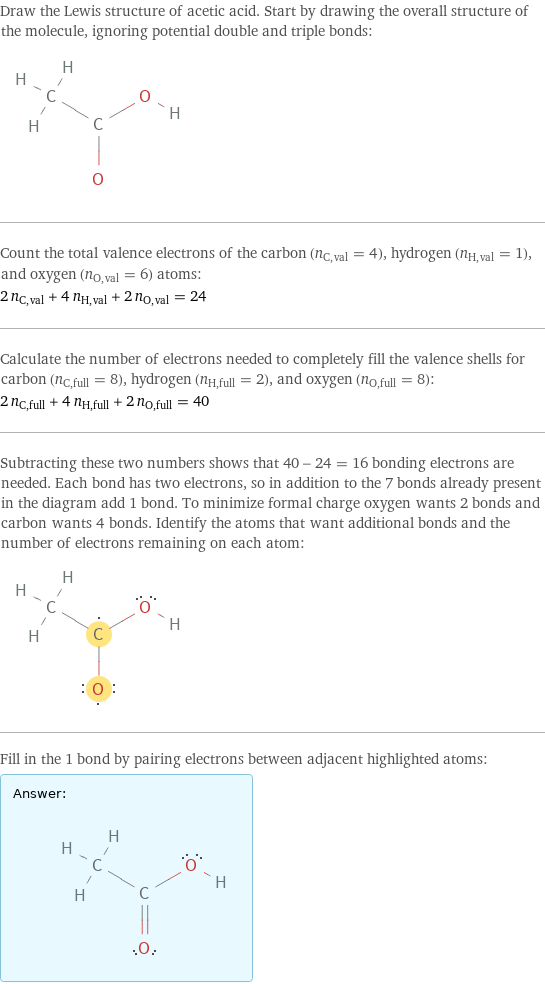
Draw the Lewis structure of acetic acid. Start by drawing the overall structure of the molecule, ignoring potential double and triple bonds: Count the total valence electrons of the carbon (n_C, val = 4), hydrogen (n_H, val = 1), and oxygen (n_O, val = 6) atoms: 2 n_C, val + 4 n_H, val + 2 n_O, val = 24 Calculate the number of electrons needed to completely fill the valence shells for carbon (n_C, full = 8), hydrogen (n_H, full = 2), and oxygen (n_O, full = 8): 2 n_C, full + 4 n_H, full + 2 n_O, full = 40 Subtracting these two numbers shows that 40 - 24 = 16 bonding electrons are needed. Each bond has two electrons, so in addition to the 7 bonds already present in the diagram add 1 bond. To minimize formal charge oxygen wants 2 bonds and carbon wants 4 bonds. Identify the atoms that want additional bonds and the number of electrons remaining on each atom: Fill in the 1 bond by pairing electrons between adjacent highlighted atoms: Answer: | |
3D structure
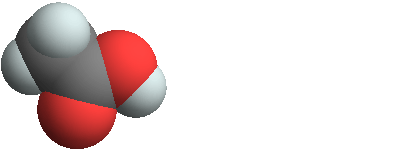
3D structure
Basic properties

molar mass | 60.052 g/mol phase | liquid (at STP) melting point | 16.2 °C boiling point | 117.5 °C density | 1.049 g/cm^3 solubility in water | miscible dielectric constant | 6.17
Hydrophobicity and permeability properties

predicted LogP hydrophobicity | -0.12 experimental LogS | 1.22 predicted LogS | 0.73
Basic drug properties

approval status | experimental | small molecule drug categories | indicators and reagent
Liquid properties (at STP)
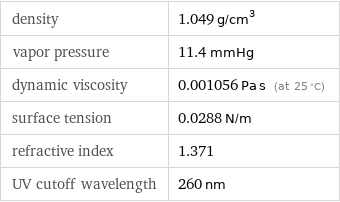
density | 1.049 g/cm^3 vapor pressure | 11.4 mmHg dynamic viscosity | 0.001056 Pa s (at 25 °C) surface tension | 0.0288 N/m refractive index | 1.371 UV cutoff wavelength | 260 nm
Units
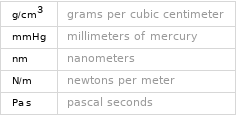
Thermodynamic properties

specific heat capacity c_p | gas | 1.056 J/(g K) | liquid | 2.053 J/(g K) molar heat capacity c_p | gas | 63.4 J/(mol K) | liquid | 123.3 J/(mol K) specific free energy of formation Δ_fG° | liquid | -6.493 kJ/g molar free energy of formation Δ_fG° | liquid | -389.9 kJ/mol specific heat of formation Δ_fH° | gas | -7.197 kJ/g molar heat of formation Δ_fH° | gas | -432.2 kJ/mol specific entropy S° | liquid | 2.664 J/(g K) molar entropy S° | liquid | 160 J/(mol K) molar heat of vaporization | 52.3 kJ/mol | specific heat of vaporization | 0.871 kJ/g | molar heat of combustion | 873 kJ/mol | specific heat of combustion | 14.5 kJ/g | molar heat of fusion | 11.73 kJ/mol | specific heat of fusion | 0.1953 kJ/g | critical temperature | 594.7 K | critical pressure | 5.791 MPa | (at STP)
Chemical identifiers

CAS number | 64-19-7 Beilstein number | 506007 PubChem CID number | 176 PubChem SID number | 3335 SMILES identifier | CC(=O)O InChI identifier | InChI=1/C2H4O2/c1-2(3)4/h1H3, (H, 3, 4)/f/h3H InChI key | QTBSBXVTEAMEQO-TULZNQERCK RTECS number | AF1225000 MDL number | MFCD00036152
NFPA label

NFPA label
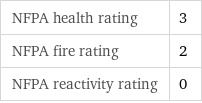
NFPA health rating | 3 NFPA fire rating | 2 NFPA reactivity rating | 0
Safety properties
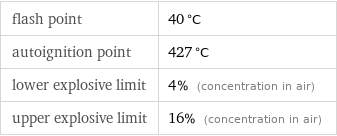
flash point | 40 °C autoignition point | 427 °C lower explosive limit | 4% (concentration in air) upper explosive limit | 16% (concentration in air)

DOT hazard class | 8 DOT numbers | 2789